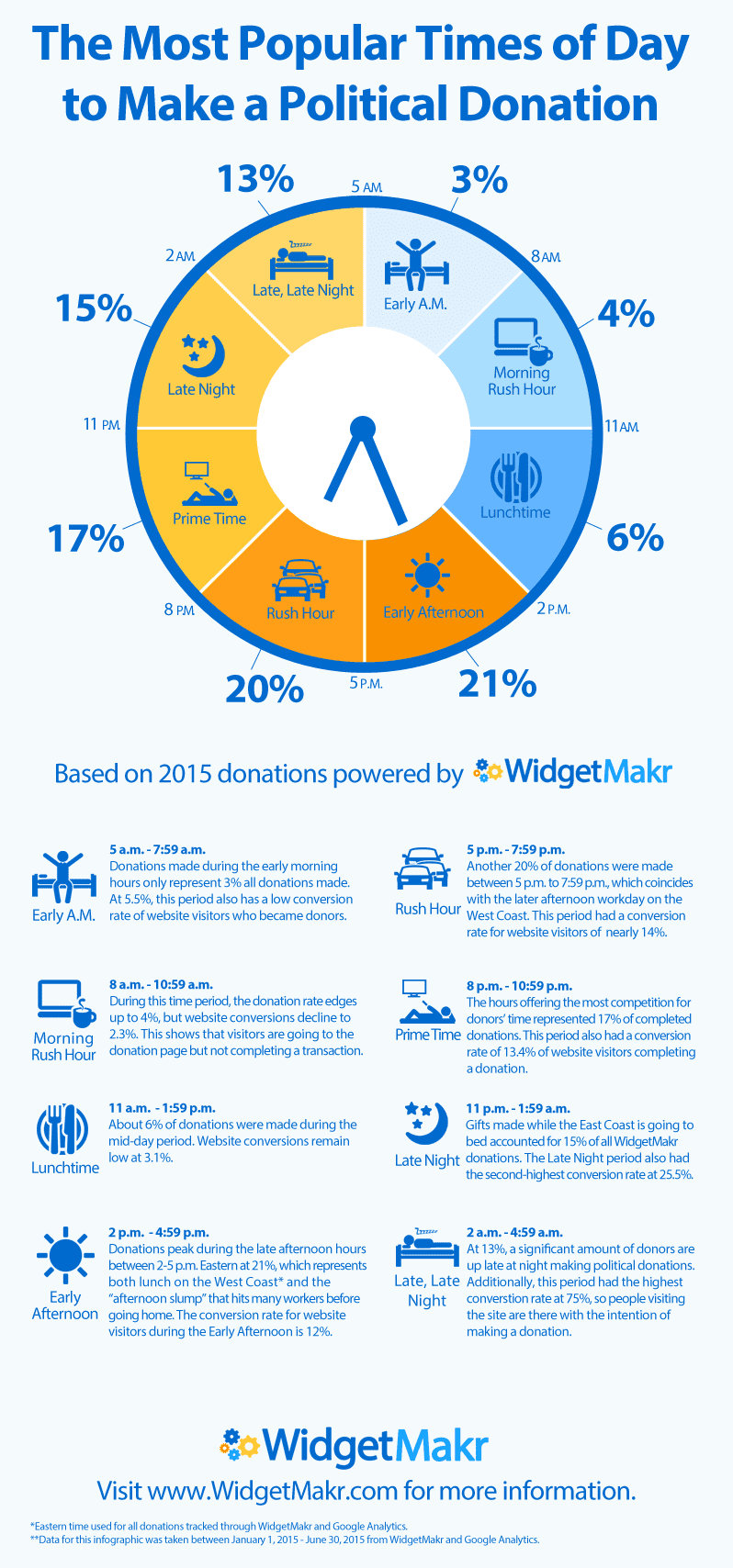The Best Time to Hit Send on a Fundraising Email
There is an ideal time of day for most campaign activities, and for fundraising emails, but it isn’t the crack of dawn. Political donors, it seems, aren’t morning people. At least that’s what some recent donation conversion rates indicate.
Seven Republican presidential campaigns and dozens of other federal campaigns are using our online fundraising platform, WidgetMakr, so we looked at data from political donations made during the first six months of this year. We also examined data from Google Analytics to see if there were any patterns in the time of day that people made political donations online.
What we found doesn’t necessarily agree with all the studies urging you to send emails early in the morning or to avoid dinner time. While open rates and clickthroughs might remain high for email at those times, donation conversion rates were often the lowest of the day.
Splitting the day into eight three-hour segments, we found that the early morning was the worst time of day for completed donations on WidgetMakr. While these hours accounted for nearly a quarter of web traffic in a 24-hour period, only 7 percent of donations were made between the hours of 5-11a.m. EST. The morning rush-hour segment – hours between 8-11a.m. – also had the lowest conversion rate at 2.3 percent.
This shows that while your subscribers might be opening up emails and clicking through to a donation page, few of them are completing a donation.
Think After Lunch or Dinner
The most popular time to complete a donation on WidgetMakr was between the hours of 2-8 p.m. The early afternoon and rush-hour segments accounted for 41 percent of all campaign donations and had an average website conversion rate of 13 percent.
It shouldn’t be surprising that afternoon and early evening are the most popular times of day to donate. The early afternoon segment – between 2-5 p.m. comprises the late part of the work day on the East Coast and lunch on the West Coast. This is a good opportunity to make the “afternoon slump” work for you when employee productivity decreases and distractions on email and social media occupy the attention of potential donors.
Campaign donations remained high during rush hour from 5-8 p.m. Despite evening commutes, dinner, afterschool activities and family time, 20 percent of donations were made during in this period. Rush Hour accounted for nearly 16 percent of daily web traffic and 13.7 percent of visitor-to-donor conversions.
Woo Your Night Owls and Insomniacs
Website traffic might decrease after 11 p.m., but the rate of completed donations remained relatively high. During the late-night hours, 11 p.m.-2 a.m., 15 percent of campaign donations were made. While this time period only accounted for 6 percent of daily website traffic, it saw conversion rates of nearly 26 percent.

The late, late-night donors are the most surprising. Slightly more than 13 percent of donations were made between 2-5 a.m. This segment had the lowest amount of website traffic, just 2 percent of daily totals, but the highest conversion rate at 75 percent.
If someone visits your donation page at this time of day, he or she is most likely to complete a transaction. Most surprising in this report was the realization that donations made during late, late night accounted for the total amount of donations completed between 5 a.m. – Noon.
A Few Caveats
Or data offers some insights into when donors are ready to sit in front of a computer or tablet and pull out a credit card. It doesn’t take into account what drove supporters to make a political donation. We looked at when a donation was made in WidgetMakr and the peak web traffic hours in Google Analytics.
Traffic to your donation page can be driven by a fundraising email, TV appearance, social media update, in-person event, or any other factor that prompts a potential donor to visit your site.
The data encourages campaigns to look beyond email statistics when determining the time of day to ask for donations through online channels. In addition to following open and clickthrough rates, check the timestamps on your donation data to see if there are better or worse times for your donors to give.
Adrienne Royer is the Digital Communications Strategist at CMDI, overseeing all digital marketing efforts for the organization.
Editorial Note: The original version of this story indicated the data relied on was gleaned from seven Republican presidential campaigns. In fact, the data was compiled based on donation patterns of dozens of federal campaigns over the first six months of the year.
